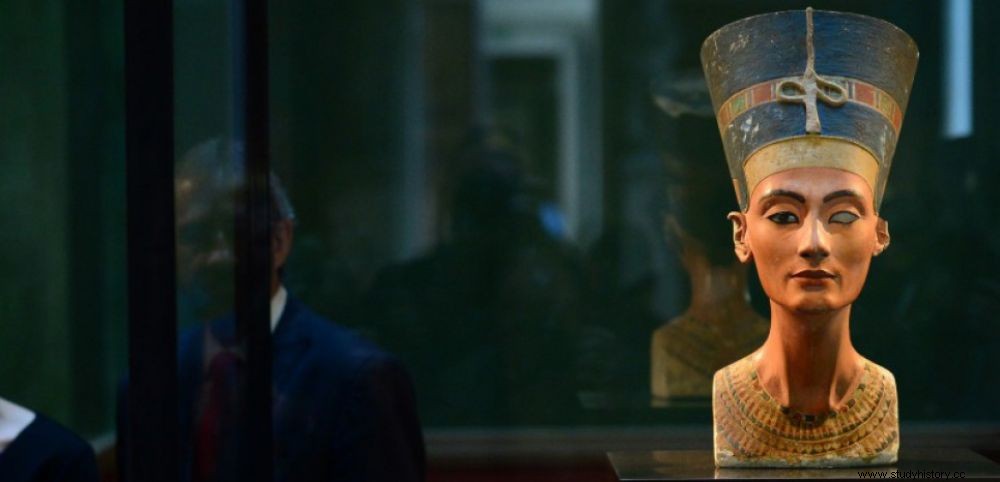 The bust of Nefertiti in the Neues Museum in Berlin.
The bust of Nefertiti in the Neues Museum in Berlin. SEARCH. Let's go ! On Thursday, November 26, 2015, British archaeologist Nicholas Reeves is expected to carry out sophisticated radar examinations in the tomb of Tutankhamun (KV62), in the Valley of the Kings, near present-day Luxor, Egypt. He searches there for the possible presence of two unknown cavities, one of which could turn out to be, according to his hypothesis… the inviolate burial of Queen Nefertiti (1370-1333 BC). Initial infrared thermography measurement campaigns on the interior walls of Tutankhamun's tomb, carried out at the request of Mamdouh Eldamaty, Egyptian Minister of Antiquities, took place on November 5 and 6 by the HIP Institute and the project teams Scan Pyramids . They have already delivered very encouraging results, in particular reporting strange temperature anomalies on different sectors of the north wall. We will therefore have to wait a little longer to find out if the legendary Queen Nefertiti can be found in this tomb already occupied by the young pharaoh Tutankhamun, who died in 1324 BC...
What do we really know to date of the disappearance of the famous royal wife of Akhenaten (Amenhotep IV) (1350-1333), the father of Tutankhamun and the first monotheistic ruler of Egypt? The "Beauty has come" (the other name of Nefertiti), could she really have been buried in this tomb in the Valley of the Kings, or, as some specialists think, has her mummy already been found? ?.
Were Akhenaten and Nefertiti the victims of a plague epidemic?
One thing is certain:the fate of the famous sovereign is indeed inextricably linked to that of the tumultuous history of her husband, pharaoh of the 18th dynasty. During a religious revolution, he had the image of the ancient gods of Egypt replaced by that of a single solar disk, Aten, and had transferred the capital to the site of Tell Amarna, in Middle Egypt. It is in this city called "The Horizon of Aten", that he had made a vow to be buried with the members of his family. Hypogeums and necropolises had therefore begun to be dug into the mountain on the edge of the Amarna plain. But Akhenaten dies in the 17th year of his reign, followed by his mother Tiyi, then his daughters... before Nefertiti also dies. "We know that tomb 30 of Tell Amarna, intended for Akhenaten, was altered to accommodate in turn his youngest, Mâketaton, a 9-year-old girl, then Neferourê and Sétepenrê, two younger children, and finally, Neferneferuaten , a fourth princess, said “The Young "", explains the Egyptologist Pierre Tallet, from the University of Paris-Sorbonne. Successive deaths that written sources explain by an epidemic of plague which would have raged in the region and of which Akhenaten and Nefertiti, would have been the victims...
It is therefore proven that most of the royal family ended their days in the city of Tell Amarna and everything indicates that it was the same for Nefertiti. But "the conditions of his burial remain mysterious" , continues Pierre Tallet. There is no evidence to establish whether she was really buried in the extension of the tomb of Akhenaton which had been assigned to her. "His remains may have been temporarily placed in another tomb in the royal necropolis" , says the archaeologist. Some fragments of sarcophagus were indeed discovered in the hypogeum n°28 of Amarna. "And it is not impossible that it was from this sector that the feet of a shabti* reached us [statuettes accompanying the deceased Editor's note], bearing the inscription of "great royal wife, Neferneferuaten Nefertiti, may she live forever “says Pierre Tallet. "This element of statuary constitutes the only tangible proof that Nefertiti was indeed buried in Amarna, as indicated by the stelae on the borders of the city" .
REBURY. But did Nefertiti's body remain in Amarna or was it transferred for political reasons to Thebes, as were those of Tiyi and Akhenaten? It is indeed admitted that transfers of the remains of members of the royal family were ordered during the reign of Tutankhamen, in order to rebury them in a hiding place in the "Valley of the Kings". Which would be tantamount to saying, corroborating the postulate of Nicholas Reeves, and other Egyptologists, that his tomb, indeed remains to be discovered!
For many Egyptologists, the potential discovery of a mummy in a hidden chamber of Tutankhamun's tomb could however concern other candidates than Nefertiti. In particular Akhenaton's eldest daughter, Merytaton who could also be queen who reigned as Ankhkhepuroure, where Kiya, "the noble lady", another of his wives. ). All bets are off on what would be "the discovery of the century", in the words of the Egyptian Minister of Antiquities!
*The fragment of ouchebti found at Tell Amarna, bearing the title of Nefertiti, was probably stolen by workers during the English excavations of the site in 1931-1932. It would have been resold on the art market in 1933, with others belonging to Akhenaten. This object is currently on display at the Brooklyn Museum, near New York. Another fragment of the ouchebti in question could be found in the Louvre Museum...
*To find out more, read the beautiful book by Christian Leblanc Reines du Nil , Library of the Introuvables, 2009.
"Twelve queens of Egypt who changed history" , by Pierre Tallet, Pygmalion editions.
